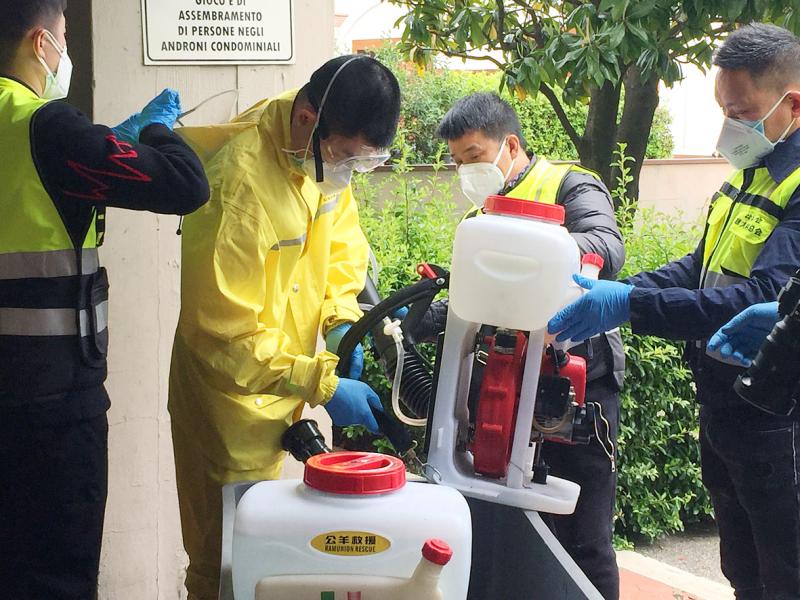An unexpected victim of the coronavirus crisis is one of Italy’s largest Chinese communities, now dwindling rapidly after more than 30 years of growth in a small town in Tuscany.
The Chinese began to settle in Prato, 17km north of Florence, around the end of the 1980s, attracted by plentiful work in factories serving Italy’s clothing industry.
Mostly from the eastern region of Zhejiang, they created a parallel industry producing low-cost fabrics alongside up-market Italian businesses supplying the country’s fashion houses.

Photo: Reuters
The close-knit community grew year by year until it numbered around 25,000 at the end of 2019, when there were about 6,000 Chinese businesses in the town of 200,000 people, making Prato one of Europe’s largest concentrations of Chinese-run industry.
Then, in spring last year, the coronavirus hit. About 2,500 people, or 10 percent of the community, have since left. For many Chinese in Prato, COVID-19 was a tipping point, intensifying doubts over their future in Italy, Europe’s most sluggish economy.
First, the Chinese suffered discrimination as alleged spreaders of the disease. Then, as the community emerged almost unscathed amid Italy’s growing death toll, they were held up as a model of how to fight it.

Photo: Reuters
Now many are giving up, worn down by the COVID-induced recession and lured back to China by its greater success in combating the pandemic and brighter economic prospects.
SAFER IN CHINA
Simona Zhou, 50, returned to Zhejiang last July after almost 30 years in Prato, leaving her knitwear factory in the hands of her family.
Suffering from a chronic illness, she felt vulnerable to the coronavirus and safer staying with her mother in China where the disease had been all but stamped out.
“If she came back here she would have to stay mostly at home, but in Zhejiang there are no restrictions and people don’t even have to wear masks,” says Simona’s daughter Teresa Lin, a member of Prato’s town council.
Italy has seen more than 124,000 COVID-19 deaths, while China has reported fewer than 5,000. However many Chinese have left because of economic hardship rather than fear of contagion, as Italy’s low-budget textile industry has been hammered by repeated lockdowns.
The economy is now gradually opening up, but for many Chinese textile workers, the damage is done.
Huang Miaomiao, a journalist from Zhejiang who lives in Prato, estimated about 2,500 people, or 10 percent of the Chinese community, had gone back to China over the last year. Marco Wong, another town councilor, said the figure was “realistic.”
Official data is out of date because it can take years for returnees to inform Italian authorities, if they bother to do so.
“There is a lot of discussion in the community about going back among people who came here in the 1980s,” said Wong.
“They see China’s economy is growing, and its handling of the pandemic strengthened a positive view of their country of origin compared with how things were managed in Italy.”
The Italian economy contracted by a steep 8.9 percent last year, and lost half a million jobs in the 12 months to March.
While growing numbers of Chinese are leaving Prato, new arrivals have dried up, according to a town council manager, who cited school enrollment numbers.
Up to 2019, around 200 new Chinese pupils per year were enrolled in Prato’s schools, he said, while in last year and this year the figure was “statistically irrelevant, practically zero.”
SHADOW ECONOMY
Prato’s Chinese community has been hard hit by the recession because many worked in the shadow economy. This meant they were not eligible for government support based on businesses’ tax returns for the previous year.
“Most of the Chinese firms in Prato are in great difficulty,” says Luigi Ye, president of Prato’s Italy-China Friendship Association which has offered financial help to 800 Chinese families over the last year.
Prato’s Chinese traditionally help each other and shun public welfare, but this “self-help” philosophy has crumbled in the face of growing poverty due to the COVID-19 crisis.
Last year the council received 449 requests from Chinese for food tokens, and 218 requests for help to pay the rent. In 2019 not a single Chinese person asked for rent assistance.
“The problem is that here there is no work anymore, there is only fear,” said Luca Zhou, who heads the Chinese community’s civil protection association. “Lots of Chinese have left, and lots more want to leave.”

June 2 to June 8 Taiwan’s woodcutters believe that if they see even one speck of red in their cooked rice, no matter how small, an accident is going to happen. Peng Chin-tian (彭錦田) swears that this has proven to be true at every stop during his decades-long career in the logging industry. Along with mining, timber harvesting was once considered the most dangerous profession in Taiwan. Not only were mishaps common during all stages of processing, it was difficult to transport the injured to get medical treatment. Many died during the arduous journey. Peng recounts some of his accidents in

“Why does Taiwan identity decline?”a group of researchers lead by University of Nevada political scientist Austin Wang (王宏恩) asked in a recent paper. After all, it is not difficult to explain the rise in Taiwanese identity after the early 1990s. But no model predicted its decline during the 2016-2018 period, they say. After testing various alternative explanations, Wang et al argue that the fall-off in Taiwanese identity during that period is related to voter hedging based on the performance of the Democratic Progressive Party (DPP). Since the DPP is perceived as the guardian of Taiwan identity, when it performs well,

A short walk beneath the dense Amazon canopy, the forest abruptly opens up. Fallen logs are rotting, the trees grow sparser and the temperature rises in places sunlight hits the ground. This is what 24 years of severe drought looks like in the world’s largest rainforest. But this patch of degraded forest, about the size of a soccer field, is a scientific experiment. Launched in 2000 by Brazilian and British scientists, Esecaflor — short for “Forest Drought Study Project” in Portuguese — set out to simulate a future in which the changing climate could deplete the Amazon of rainfall. It is

Artifacts found at archeological sites in France and Spain along the Bay of Biscay shoreline show that humans have been crafting tools from whale bones since more than 20,000 years ago, illustrating anew the resourcefulness of prehistoric people. The tools, primarily hunting implements such as projectile points, were fashioned from the bones of at least five species of large whales, the researchers said. Bones from sperm whales were the most abundant, followed by fin whales, gray whales, right or bowhead whales — two species indistinguishable with the analytical method used in the study — and blue whales. With seafaring capabilities by humans